The cheap hotel offers an awful breakfast, but I know I need the calories and have no time looking for something else.
For many years, I used to negotiate with the taxi driver, before I jumped in. Meanwhile, I use another method. I don’t discuss prices upfront, I just let me drive and when I arrive, I give the money I think is fair. When the driver asks for more, I boldly lie by declaring that this is what I paid last time. Usually, he or she agrees.
At the airport café, I use the free WIFI to check my mail. (WIFI in the cheap hotel was unusable and I am running out of Megas, as they call the cellular data volume here. I tried to purchase more Megas the day before in Mollenda, but they all wanted to sell me post-pay contracts, no pre-pay. And nobody could tell me how to recharge my pre-paid chip.)
My PCR test should have arrived by now, but it hasn’t. And the Chilean authorities did not process my vaccination recognition request. Without this, I cannot get the Pase de Movilidad and without it I am not allowed into Chile. I waited now 6 days for it. The web app says, it may take up to 10 days. 4 days more in Tacna? No way!
Let’s start with the Peruvian process to leave the country, see which surprises this brings. A friendly airport officer helps me through security and brings me to the flight plan office. I file a flight plan to Iquique, but he checks all data carefully and finds out that my Peruvian permit stated Arica as first airport after leaving Peru. This is right, initially I thought Arica is a good idea, but now I would have preferred going directly to Iquique.
But not with Tacnan AIS, Arica it is. At least, he accepts Iquique as alternate. Paperwork is enormous. They make me fill out 20 forms. No, I don’t transport dangerous goods. No, I don’t transport weapons. No, no endangered species. No, no mail and no cargo.
Where is your first officer? someone wanted to know. I am surrounded by people; they all want something signed from me. One of them has my PCR test, it is negative. How did he get it? This is good, he says, as far as I am concerned, you may fly.
The border police arrive. Tacna is an international airport, but they don’t have scheduled international flights, so the police only comes, when someone crazy like me flies international. They show me a form I should have received when flying the plane into Peru. I don’t have this form and don’t remember it. I would have received it two years ago. Two years is a long time. I even check my cloud, where I keep all docs I scanned – but no joy. They carefully check my entry stamp from two years ago and apparently contact Chiclayo to get the document from them. Where did you park the plane in those two years? One of the officers asks. In a hangar, I say. Where is the contract for that hangar? Where is the invoice? He asks. I got asylum in a friend’s hangar together with ultralights, I say truthfully. They are satisfied in that respect and change the topic.
Customs here is a lot friendlier than customs in Colombia. They are the worst. All in all the paperwork takes nearly an hour but then they let me go. I have to pay the airway fees and the landing fee. They expect US dollar and are surprised, when I prefer paying in soles. (I want to get rid of them now.) After I paid, they say that I may now fly to Arica. Arica is just behind the border, a 15-minute flight.
But secretly, I plan to divert to Iquique, when clear of Peruvian airspace. Why should they care? And Iquique is two hours away. As I couldn’t get Avgas here in Tacna or at my last airfield Mollenda, I refuel using my petrol cans. The crew of the LATAM A320 next to me doesn't care:
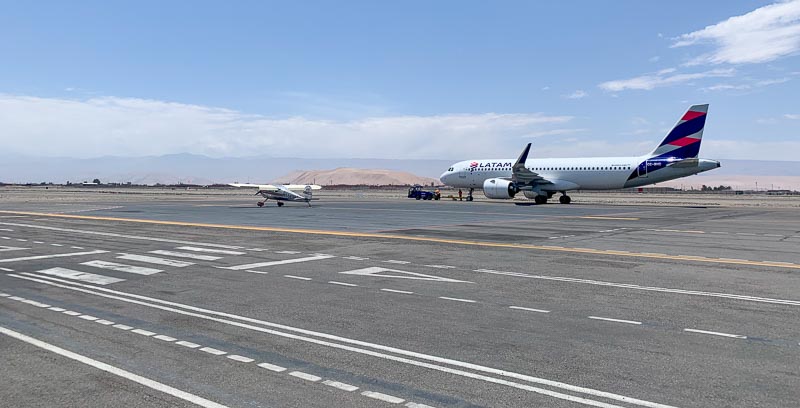
The wind has picked up. I still respect the wind, but it doesn't scare me in any way. It is a nuisance for taxi and even dangerous when parked, but not much to worry about for most takeoffs and landings.
When Tacna tower sends me over to Arica tower the change in aviation spirit was feelable. Service orientation was higher, English was better. Very professional. And I wanted to be professional too and didn’t want any more to play the diversion game. So, I landed in Arica. How bad, that my Chilean entry permit stated, that I should do customs in Iquique.
What are your intentions, asked the friendly tower lady. Refuel, I say. Are you familiar with the airport? She asks and when I admit that this is my first visit to Arica, she guides me around the numerous construction works to the Avgas pump. I am impressed. Very service oriented. Alone at the pump, I even think it possible, that this is a self-service gas station, like in the US. But it is not, after a while, a fueler appears. He accepts VISA and fills my plane. As usual, they overfill and spoil Avgas on my wing fabric.
I taxi over to the terminal and file a flight plan to Iquique. I ask the dispatcher, where may I pay my landing fee and airway charges. He doesn’t understand my question. Apparently, there are no VFR airway and landing fees in Chile. Wow! This is even better then Panama or Germany; this is LIKE IN THE USA! I am really flashed. They even allow me to walk into the small terminal. (Remember: I have not gone through immigration.) Unfortunately, the cafeteria in the terminal is closed. I am a bit hungry by now. The ATM gives me my first Chilean money. But nobody sells cellular chips. (Understandable, as there are nearly no international flights at this international airport.) Normally, the minimum time between filing a flight plan and take off is one hour, but after 30 minutes, they let me go.
It is windy again. Wide-eyed I see an A320 land with at least 15 knots tailwind. Why are they doing this? Maybe because Peru is so close, and they don’t want to overfly the border when using the other runway? I don’t know.
N5581M takes off with headwind, of course. Beautiful Arica harbor comes in view:
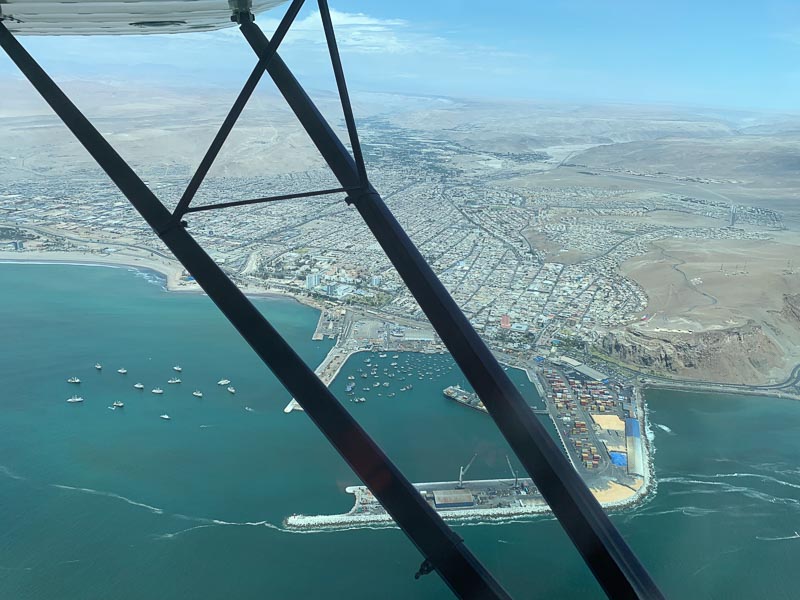
The cliffs behind Arica are spectacular.
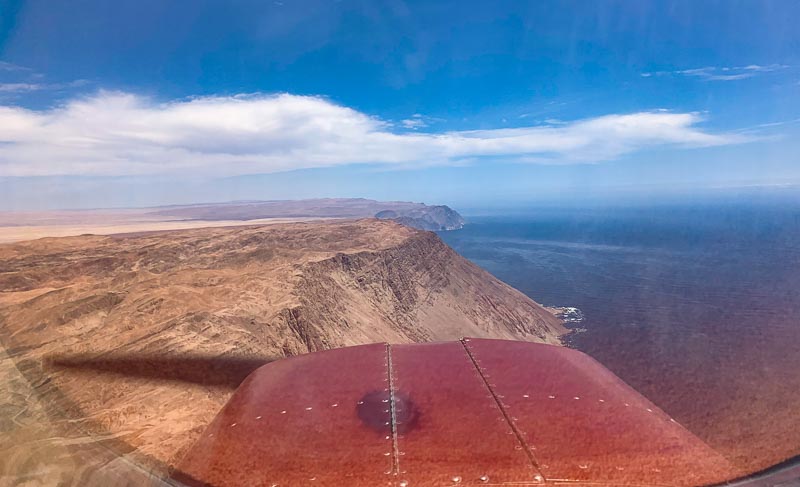
I misplaced my iPad, so I use my iPhone for navigation and for making pictures. Switching roles all the time. Without the full tanks, 81M climbs easily to 5500 feet. It is an enjoyable flight. After Arica Tower says good-by, I fly for about 30 minutes in silence, before I hear Iquique approach.
To the left: Desert:
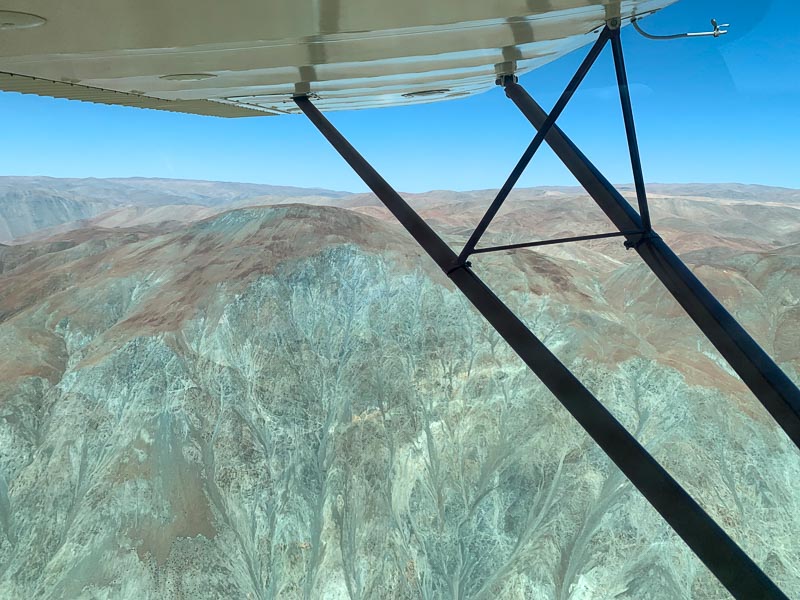
Sometimes divided by canyons with green riverbanks:
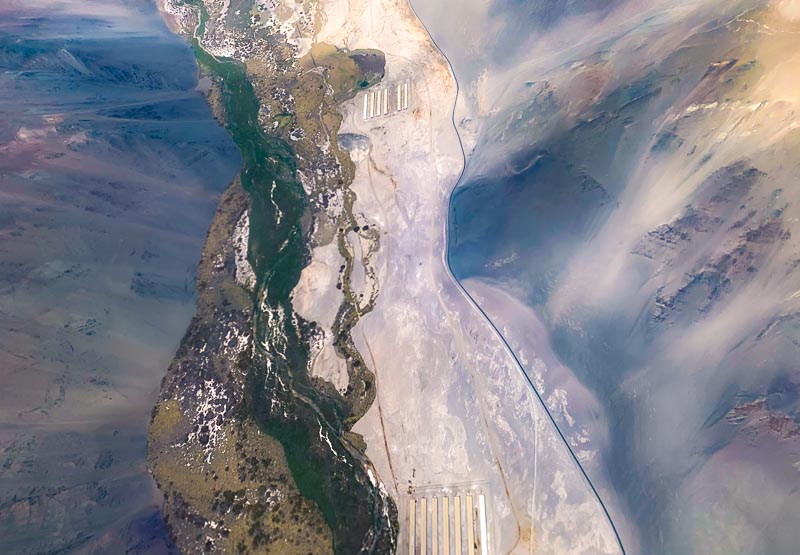
To the right, the Pacific Ocean. Just endless blue.
Straight ahead, the coastline. Desert merging with the blue. Some times a few clouds below me:
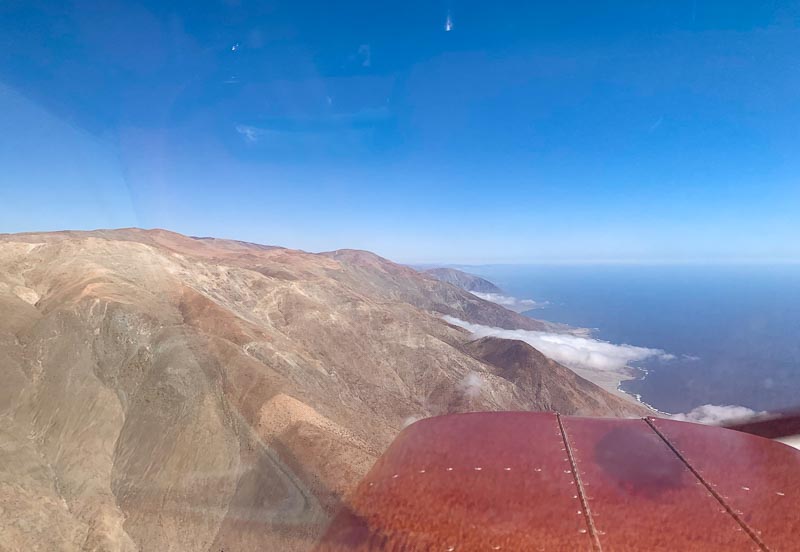
Navigation is trivial. My main task is looking for emergency landing sites. Usually, there are many. Either on the cliffs or on the beaches. Sometimes a road. But a few times, there are neither beaches, nor roads. The cliffs, rugged and sometimes above my flight altitude, end directly in the ocean:
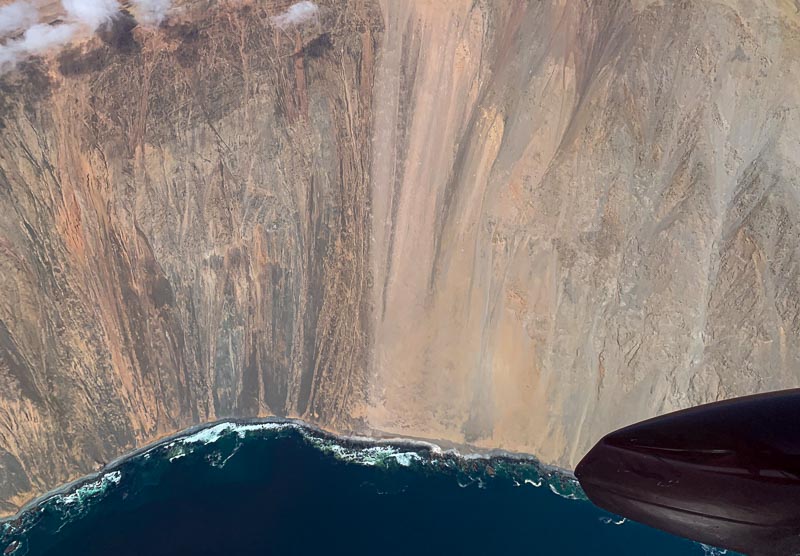
There aren’t any airports. Roads have next to no traffic - they are usuable. In many regions, roads are pested by telephone poles, here they are clean. I don't mind, if they are windy. Brian has teached me to land in a turn. Tunnels would be issues, but there are few. Sailing to a road is easy, they are like an endless runway. No calculation necessary. But most of the time, there is no road and I would have to use small spots in the desert. So, I am always checking: distance, length, ground condition, slope, wind. I avoid flying over water. Only if the beaches offer good landing possibilities.
No restricted areas here, much better for single-engine aircraft as the Peruvian cost. After 1,5 hours, I see the city of Iquique. It has skyscrapers. It looks modern:
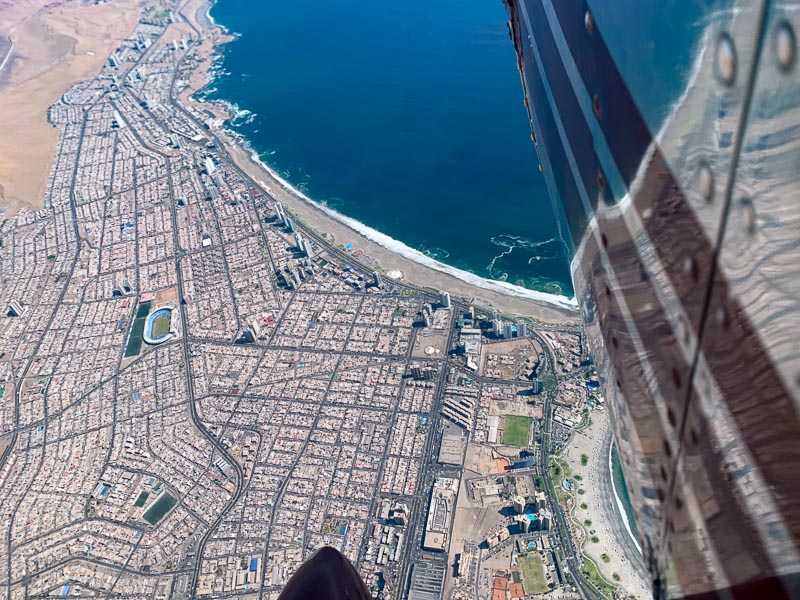
Much smaller than Panama City, but somehow similar. The airport is further south.
After landing, I taxi to the gas station. Only cash and we have no change, he says. I accept. For 32 liter he wants 50300 Pesos. I give him six 10.000 Peso bills. The ATM gave me no smaller bills. You really don’t have 300 Pesos? No, you may keep the rest, I say with a faked smile.
Now taxi in front of the main terminal for immigration, the nice tower lady says. The local pilots call her senorita, but I can't copy that. Fräulein is a bit outdated, isn't it? I park next to an LATAM A320. The immigration officer comes in three hours, she says. What?
It is hot. The sun is burning. The wind blows. It contains sand and salt. And I am hungry. A friendly airport agent buys me sandwiches and gives me the change.
I am not allowed into the terminal. Of course, my Peruvian chip does not work anymore. Maybe my Argentinian Claro chip does? Where is the famous Apple SIM changing tool? Can’t find it. But I have a complete aircraft toolbox. Maybe a needle-plier? No. Nothing works. Finally, I find an office paper clip in my Aircraft Spruce kit of Cessna screws. This does the job.
Claro offers a 1 Gig roaming package for 1000 Argentinian Pesos (5 – 10 Euro, depending how you count). I am grateful that roaming exists. My mail floods in. Hurrah, Chile accredited my vaccinations. I get the Pase de Movilidad. After a while, a man appears: Any fruits? He asks. Nope, I reply. An hour later, the COVID squadron comes by: Where is your Pase de Movilidad? Here it is! The three are happy and leave:
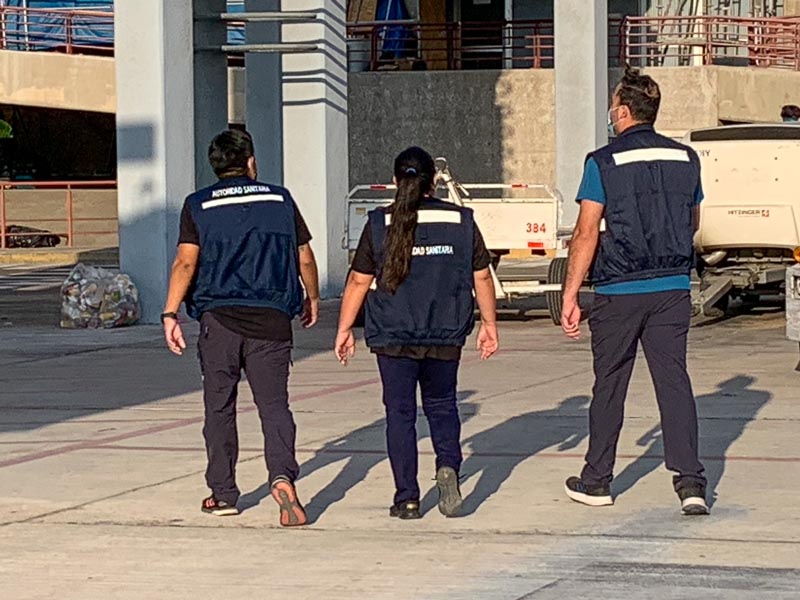
A marshaller comes and tells me that the airport needs parking stand 3 for an A320, could I please taxi over to stand 4? He is ready to marshall me in, but starts laughing when he sees that I, instead of taxiing with the engine, simply push the Cessna over.
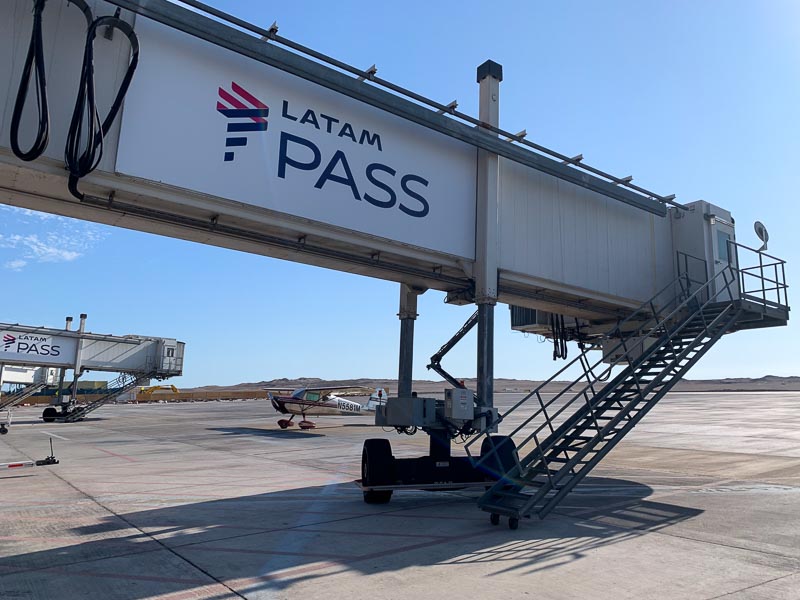
Another group comes. They want to see the empty desinfection sprays. I don’t have any - but point to one of the numerous forms I filled out in Tacna which claims that the aircraft has been disinfected. They accept this. Puhhh! Another one comes. He wants to see what is in the plane. They inspect the plane a bit, but not thoroughly. The only ones who really checked thoroughfully, was the drug police in El Salvador.
Finally, someone comes and says that the immigration officer has now arrived, and I should come to the terminal. It is half past eight, I waited for nearly 4 hours. It is a lady in jeans, no uniform. Maybe secret police? Some questions, some forms, careful checking all the stamps in my passport, then she stamps it. Welcome to Chile, she says. Apparently, she drove all the wait out to the airport, only for me. She leaves.
Nobody tells me, why I had to wait 4 hours. What did I do wrong? What should I do differently next time? I have no idea. They knew I was coming. It was in my permit and my flight plan. Nobody had advised me that I need to prearrange customs. Anyhow, I am happy. They escort me back through security to the apron.
I taxi the plane over to the Aeroclub. It is dark by now, but I have a bright landing light. The Aeroclub is nearly 4 km away. Nobody is there. I tie down the little taildragger with a nail in the sand, kiss it goodbye and start walking. A fire brigade stops. Do you know it is 4 km back to the terminal, the driver asks? And the city is 40 km away. A taxi costs 40 US dollar, he says. Well, nothing I couldn’t solve. Just before midnight, I am in the Holiday Inn. The bed is nice. It is an expensive hotel.
Uber works in Chile. The 30-minute drive along the coast costs 20 US dollar.
Carlos, a local pilot, tells me via WhatsApp that I should go via the Terminal, because there is nobody at the Aeroclub who could let me in. When requesting startup, ramp control tells me, I must pay my taxes. Are there after all landing fees in Chile? No. In the flight plan office they tell me that I must pay for a 30-day permission to fly within Chile. Ok, this is like Panama, then. But no landing fees. No navigation fees. Good.
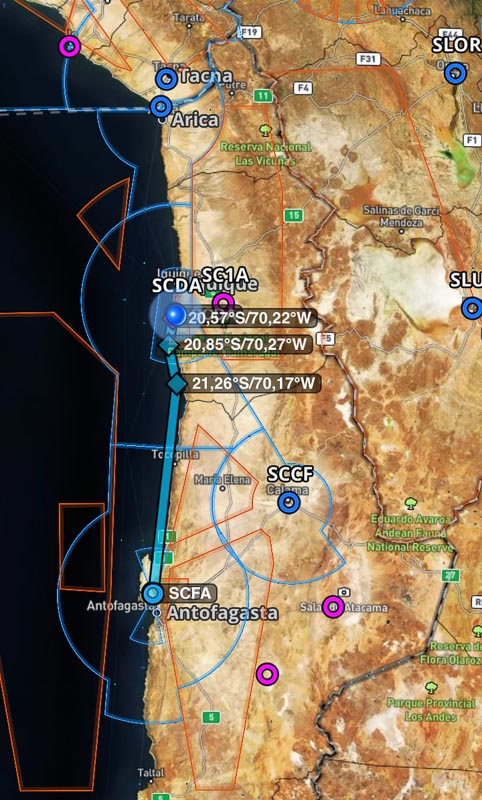
Takeoff for Antofagasta, the first 2-hour flight today. Along the coast, as usual. A straight line. Sometimes over the coast, sometimes over the water. But always within gliding distance to the beaches. Sometimes, there are no beaches, just cliffs going straight into the water. Then, I would have to land on the top of the cliffs. Sometimes, they are higher than me. I fly only in 5500 ft. Then, there is only the water. But at least close to the shoreline. I could swim there.
North of Antofagasta, I fly my very first VFR holding. There is a medical flight which has priority, I am told. They are not used to dense traffic, Tower uses large separations, leading to delays. I don’t care, I have time and I have lots of fuel. After a 2-hour flight, I have more than two hours of fuel left. Finally, they let me land.
In Antofagasta the fueling companies ignore me. I don’t know whom to call, so I stop every fuel truck I see and beg for fuel. More than an hour later, someone finally comes. I use a new trick. I don’t let them top off my wings, because this usually leads to spoiling fuel over the wing. If I really need my tanks topped off, I do this myself, using my little petrol can.
For my second flight today, I top off. I expect more than three hours flight time. It is always hard to calculate the exact flight time, because it depends so much on the wind.
If you fly 80 knots and have 240 nautical miles to go, you need three hours. But A five knots difference in wind can reduce your speed to 75 and thus increase flight time by 12 minutes. Another 10 minutes can be lost by flying inaccuratly, which easily happens if you get tired. If the engine gets too hot, then you have to reduce power, leading to a reduction in speed (and a reduction in cooling air flow, which counteracts the goal of cooling the engine) and this may increase flight time by another 10 minutes. Makes three hours and thirty minutes now. What is the endurance of a Cessna 140? Normally more than four hours. If the tanks have been topped off. If you didn’t spend too much time idling on the ground, because a tower controller uses large separations between her few flights.
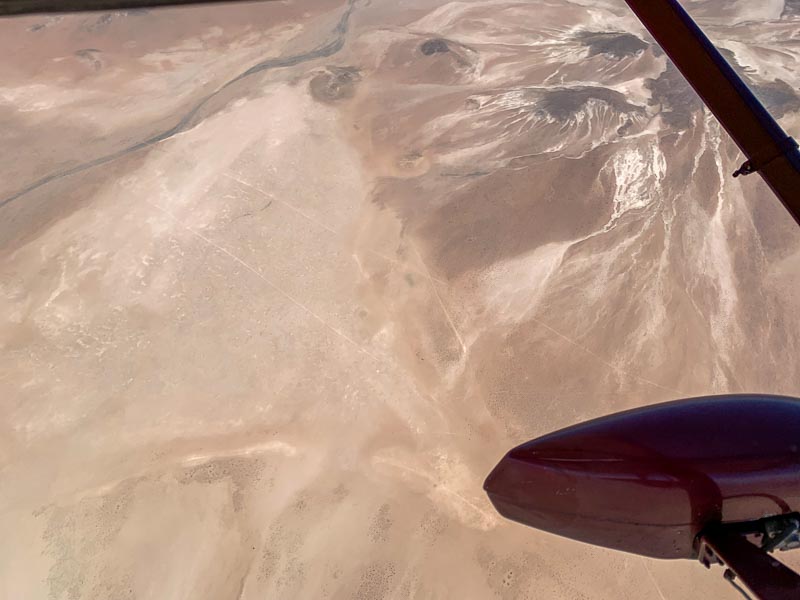
After 3 hours and 3 minutes, I land in Desierto de Atacama. There are copper and gold mines in the area. Before Chile conquered its northern provinces from Peru and Bolivia, the town of Copiapó was its most-northern mining area. Even today, most people here live from the mines.
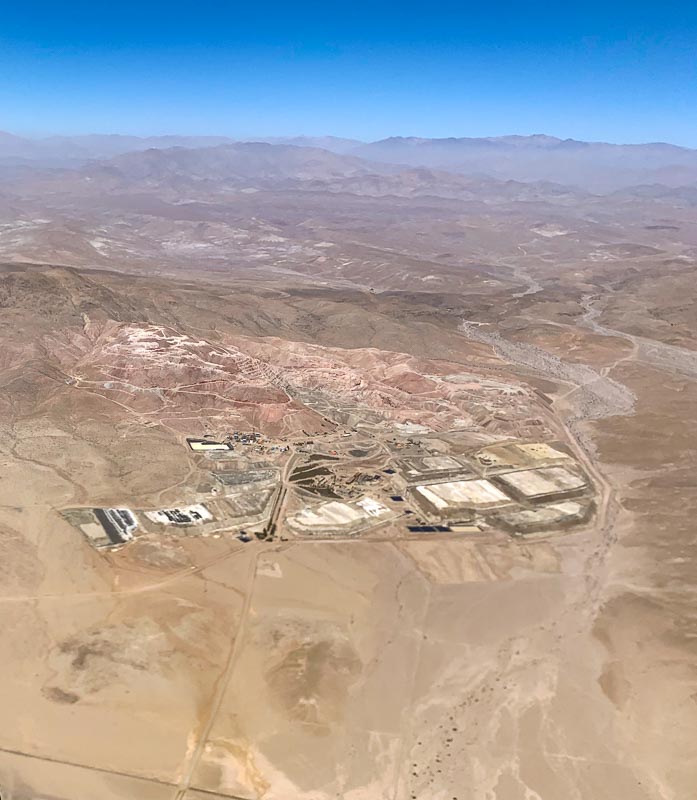
When a taxi drives me from the airport to Copiapo, which is more than 40 km away, I see abandoned railway tracks. Later I learn, this was the first railroad of South America. Built in 1850 and used to get the ore to the harbor of Caldera. Alvaro, a local pilot, invites me to a dinner with friends from his club of Ultralight pilots. They show me pictures and share stories of flying their birds over the Atacama Desert. Beautiful. I consider staying here for some days and fly locally as well. But I have a goal. I must continue. Let’s go south today.
Atacama airports sends me an email, asking whether I will fly with passengers and reminding me that if I have passengers, I will have to involve an FBO service. I receive other emails too, invoices from other airports I have passed by. With my poor Spanish it is sometimes difficult to understand if they still want me to pay something or if they are just invoices of services I already paid. It would help, if I knew for sure which services are free and which are being charged. E. g. I learned that there are VFR navigation charges per nautical miles in Peru. But they don’t exist in Chile, right? But what about overnight parking? Or going through security? Or being driven in a bus across the apron to the plane?
In front of the Atacama airport terminal, there is a long line of passengers. A guard checks airline tickets. I don’t have one. I only have my FAA pilot license. Usually, the guard don’t know what to do with me and calls his/her supervisor. This takes time. Besides, I don’t want to wait patiently in line, it’s a long line. I walk straight to the fenced DGAC operations building, right next to the terminal. They let me in.
Inside, in the flight plan office, they already have the flight plan I filed via Foreflight. I am still amazed that this works in Chile. No security here, I just go through the open door and walk to my plane. Like in the USA. Even better. An 320 lands. They are used everywhere and nearly exclusively. Airbus really has a successful product.
It is already past noon, so I will do only one 2,5-hour flight to Ovalle today. Following the coast would be a significant deviation. Following the valleys would be a detour too, so I decide to leave Atacama airport via the downwind and fly straight over the mountains:
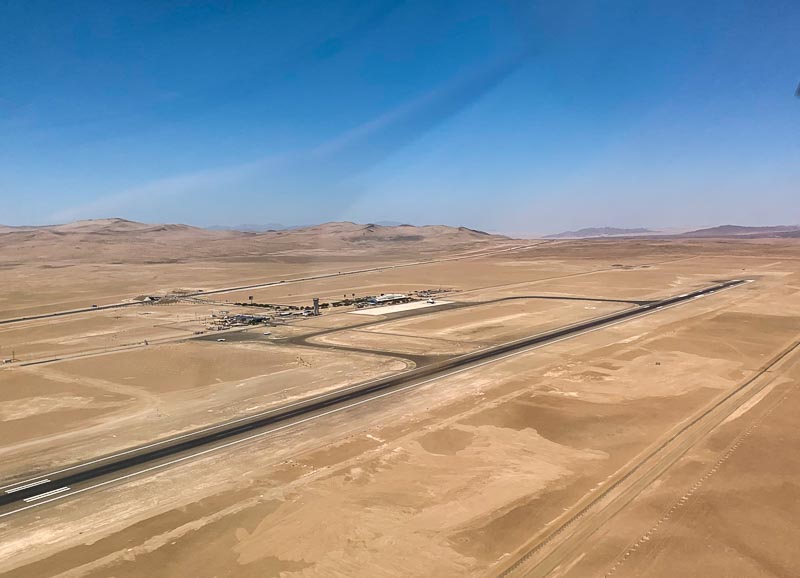
The mountains rarely exceed 5500 feet, so it is no problem:
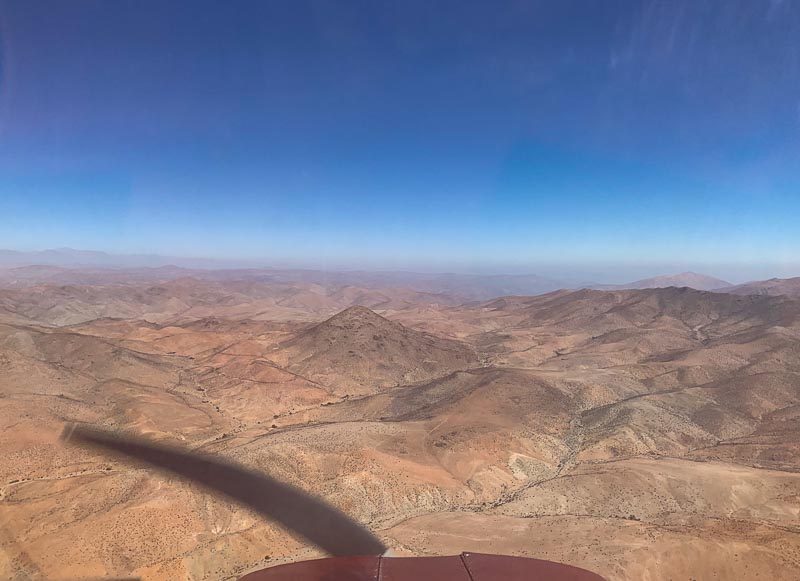
The Atacama Desert offers breathtaking views:
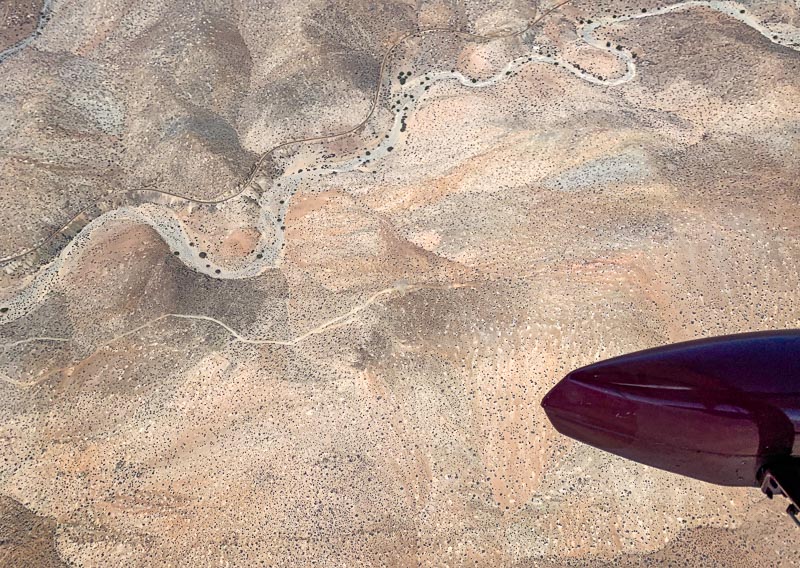
It is rich in history too. 19th century railroad lines cross the landscape. Long abandoned, the tracks are partially covered under sand. Later I learn that they mined Saltpeter in this area and exported it all over the world – until the Germans invented and industrialized a chemical process to replace it as an ingredient for fertilizers and explosives. Now it is mainly copper, gold and – lithium, the stuff needed for the batteries. Chile is a rich country. Yes, the wealth is divided unequally by European standards, but it is also true that in average, the people living here are wealthier than in any other Latin American country.
The coast line is not in sight. ATC fades into the background. Their signal is too weak to open my radio’s squelch, so I keep it on test. IFR – I Follow Roads – is back. After many days flying along the coast, I like the new challenges. Flying low means flying in turbulence and feeling the winds rolling up and down the mountains. In a Cessna 140 flying VFR, you don’t fight the winds, you use them. I let them increase or decrease my altitude The wind plays with my little plane like it would with a leaf. Of course, I keep a safe distance to the mountains, and avoid any exposure. Constantly I scan the area around me for emergency landing sites. They are numerous. I respect the desert, but I am not afraid flying here, not at all. This is my first flight to an uncontrolled field in Chile, so I looked up the procedures. Prior to take off, I called the Aeroclub in Ovalle and learned that I am welcome there.
Five miles north of the field, still in 5500 feet, I see Ovalle and ask La Serena approach to close my flight plan. No CANCEL CON ETA like in Peru. In Germany, they want you to be in the traffic pattern, before they let you close your flight plan, which is stupid, because you then can’t listen to the local traffic frequency. I think, the Chilean procedure is the best. I announce my attentions, but nobody answers. I am the only traffic here:
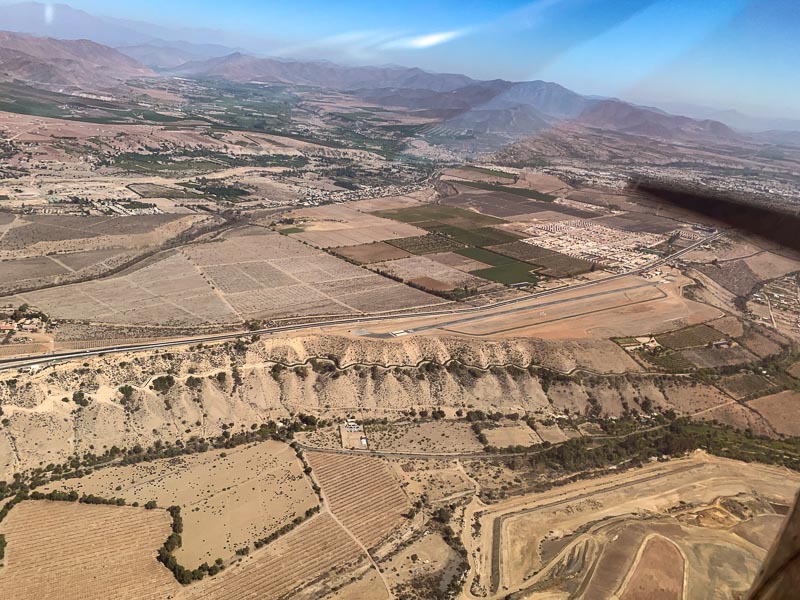
The airport has an excellent infrastructure. Beautifully paved taxiway, lighted windsock, even runway lights you can switch on by clicking your PTT, I later learn. I am impressed, even before I touch the ground. A man on a motorcycle appears.
Roberto takes good care of me. He has a beautiful hangar, normally exclusively used for a beautiful Cirrus. He pushes the Cirrus back into a corner and allows me to park my old beaten Cessna in the hangar:
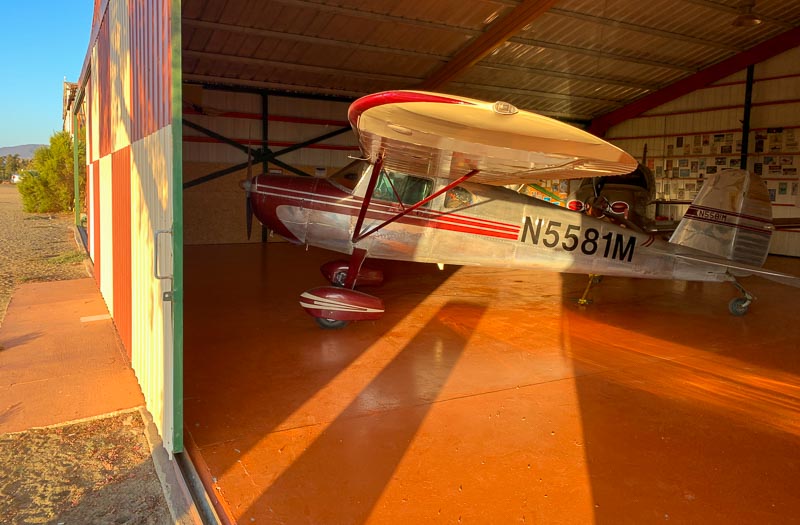
The whole valley is beautiful. I walk to a hotel nearby, shower and walk back to the airfield. Roberto invites me to participate in a meeting of his Aeroclub. They discuss club matters, then we eat Chorizo and pork, drink beer, Chilean wine and brandy while the discussion moves into politics. Matters that arouse people in Chile these days. With the constitution being subject to change, the future of the country is uncertain. Many are afraid.